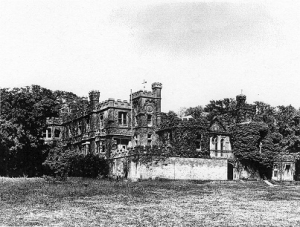5 April 1917
Bombed: Kent
On the night of 5 April the sound of an aeroplane engine was heard off the coast of north-east Kent shortly after 10.00pm but low-lying clouds limited any opportunity for observation. A single seaplane of SFA1 came inland near Broadstairs at 10.38pm before dropping four bombs on open land south of the town as the aircraft headed towards Ramsgate. According to a newspaper report ‘one found a billet in a road in a sparsely populated area between two towns, and did no material damage. The others dropped among potato seeds’. A police report confirms the breaking of 11 panes of glass in a greenhouse and at a house, estimating the damage at £4.
Just north of Ramsgate a bomb dropped in the grounds of East Cliff Lodge, the home of Mrs Harriette Sebag-Montefiore, where it damaged a few fruit trees.
From Ramsgate the aircraft continued towards Sandwich dropping three more bombs between the town and the sea where they caused no damage. Two fell close together on marshy ground about three quarters of a mile west of Shingle End Coastguard Station and the third gouged a hole four feet deep on the North Rifle Ranges. All bombs dropped were of the high-explosive type.
The raider then headed out to sea. No aircraft attempted to intercept due to the low clouds.
East Cliff Lodge at Ramsgate, where a bomb landed in the grounds on 5 April 1917
Casualties: 0 killed, 0 injured
Damage: £4
7 May 1917
Bombed: London
On the night of 6/7 May 1917 a single Albatros C VII of the Army’s Feldflieger Abteilung 19 approached London from the north-east. Offizierstellvertreter Rudolf Klimke (pilot) and Oberleutnant Walter Leon (observer) do not appear to have received official permission for the raid.
The first indication of an aeroplane over London came from Wanstead AA gun station who reported engine noise at 12.40am. Moments later a 12.5kg HE bomb landed on open ground on Hackney Marshes near the White House Inn, digging a crater six feet in diameter and three feet deep. The Albatros dropped five more 12.5kg bombs as it followed a westward course across north London.
The next bomb landed in the back garden of 130 Stoke Newington Road, breaking 40 panes of glass in the house, damaging the contents as well as smashing a number of windows in a greenhouse. The blast also smashed windows in neighbouring buildings in Stoke Newington Road and Wellington Road. Two minutes later a bomb smashed through the roof of 9 Newington Green Mansions on Green Lanes and exploded in the flat where Frederick and Annie Dawson were asleep. The bomb killed Frederick and severely injured his wife. Another woman in the building was slightly injured and five other flats suffered serious water damage when the bomb smashed the cistern. The next bomb fell on a gravel path at 19 Aberdeen Park, off Highbury Grove, where it dug a crater, smashed some glass and damaged a chicken house, killing a chicken.
The final two bombs failed to cause significant damage. One dropped on the open space at Highbury Fields, close to Ronalds Road, gouging out a three feet deep crater and smashing a water main. The other failed to explode when it struck a house at 65 Eden Grove, off Holloway Road, but still caused damage to a bathroom.
Two RFC aircraft of No. 50 Squadron took off from Bekesbourne, and two of the RNAS were airborne from Manston, but none caught a glimpse of the raider on its homeward flight across Kent.
Casualties: 1 killed, 2 injured
Damage: £510
